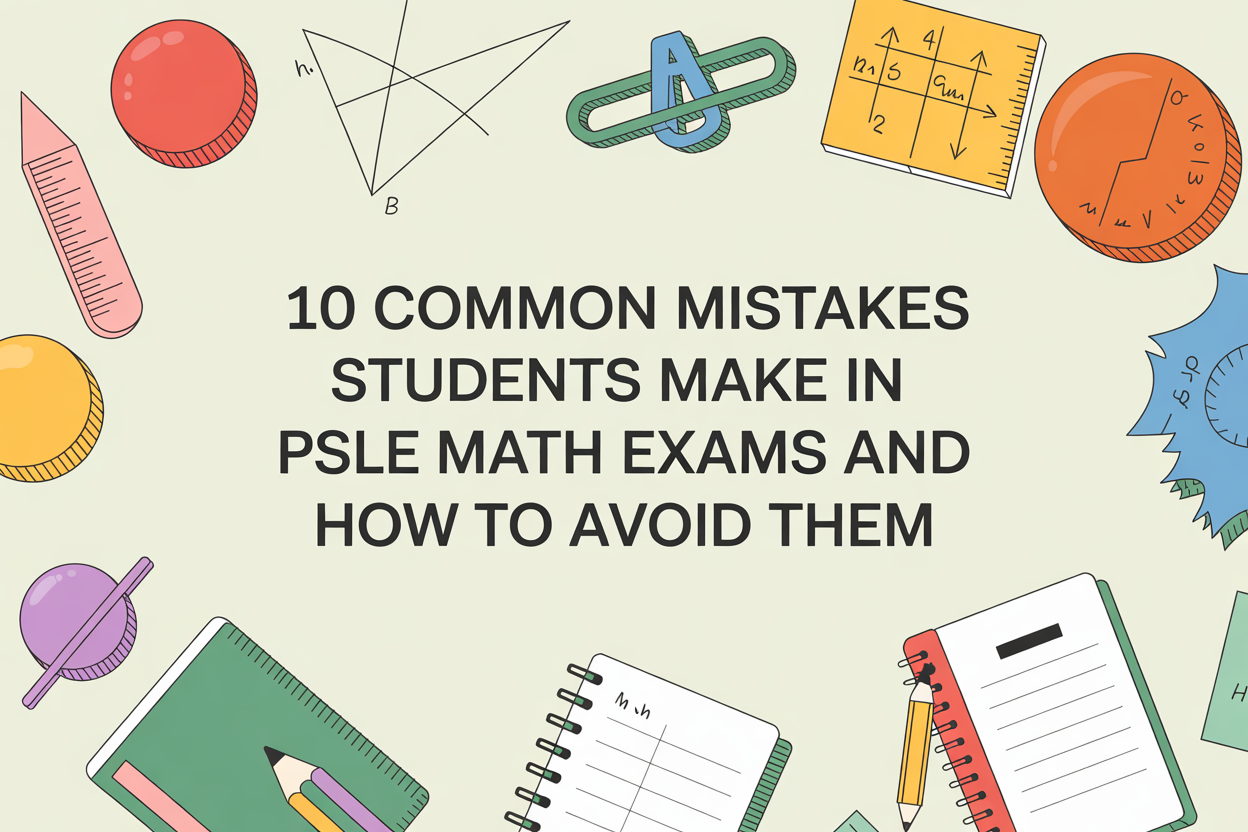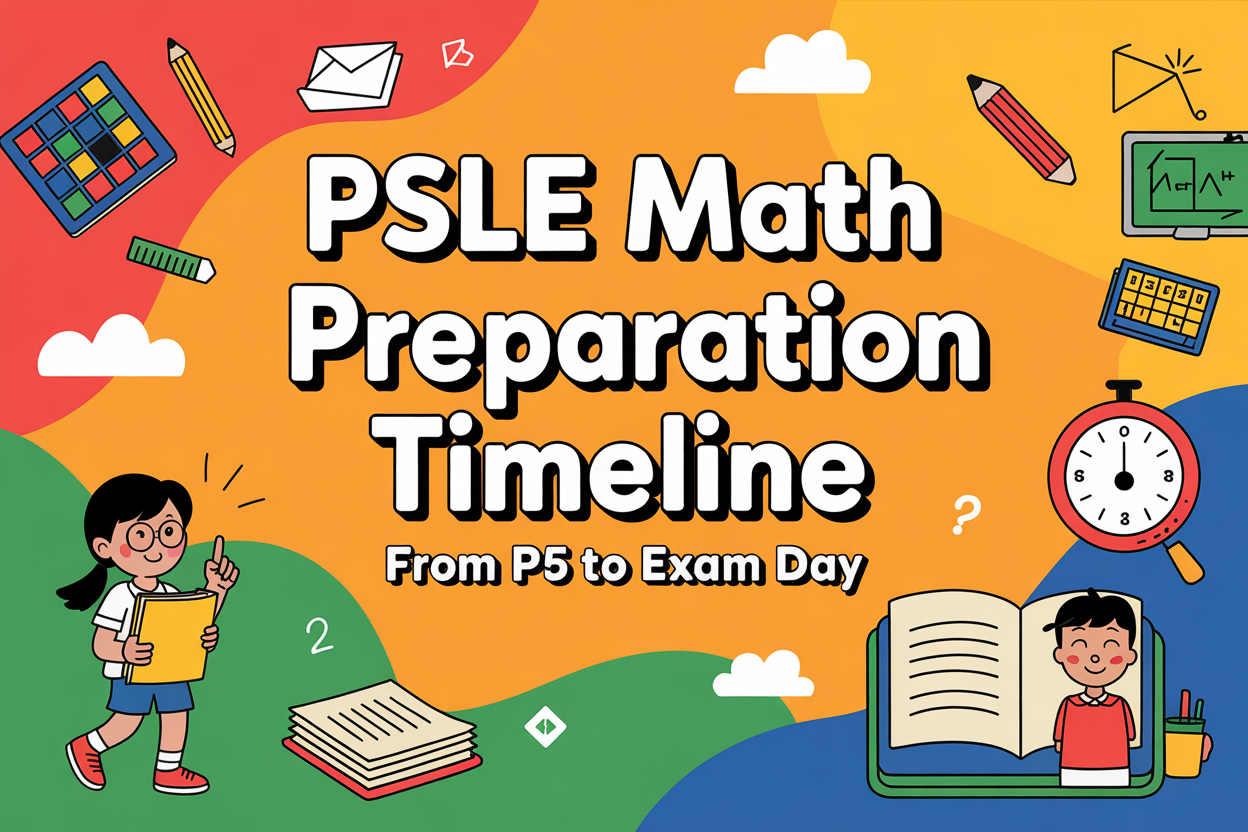- May 8, 2025 -
10 Common Mistakes Students Make in PSLE Math Exams and How to Avoid Them

Table of Contents
- Introduction
- Calculation Errors and Careless Mistakes
- Misinterpreting Question Requirements
- Formula Confusion and Application Errors
- Poor Time Management
- Geometry and Measurement Mistakes
- Number Pattern and Algebra Challenges
- Word Problem Struggles
- Psychological Barriers and Exam Anxiety
- How EduFirst’s Approach Prevents These Common Mistakes
- Conclusion
The PSLE Math examination is often considered one of the most challenging hurdles in a Primary 6 student’s academic journey, making quality Primary math tuition an essential investment that provides students with specialized strategies, personalized attention, and confidence-building practice to successfully navigate this critical milestone.. Each year, thousands of students across Singapore prepare diligently, yet many fall short of their potential due to recurring mistakes that could have been avoided with proper guidance.
According to the Singapore Examinations and Assessment Board, Mathematics consistently shows one of the widest performance distributions among PSLE subjects, indicating that while some students excel, others struggle significantly with core mathematical concepts and application.
At EduFirst Learning Centre, our experienced educators have identified patterns in student performance over the years. We’ve compiled the 10 most common mistakes students make in PSLE Math exams, along with proven strategies to overcome these challenges. Understanding these pitfalls is the first step toward maximizing your child’s performance and building the confidence needed to excel in this crucial examination.
1. Calculation Errors and Careless Mistakes
Even the brightest students can lose valuable marks due to simple calculation errors. These mistakes often occur when students are rushing through questions or fail to verify their work. Common calculation errors include:
Arithmetic Operation Errors
Many students make mistakes when performing basic operations like addition, subtraction, multiplication, and division. These errors often occur when working with large numbers or multiple steps. For example, a student might correctly set up a problem involving the area of a composite figure but make a multiplication error when calculating the final answer.
Decimal Place Value Errors
Misplacing decimal points is another frequent mistake. When converting between units (e.g., meters to centimeters) or calculating with money, an error in decimal placement can lead to an answer that’s off by a factor of 10 or 100. Students often lose marks not because they don’t understand the concept, but simply because they misplaced a decimal point.
Prevention Strategies
To minimize calculation errors, students should develop the habit of estimation. Before solving a problem, estimate what a reasonable answer might be. After calculating, check whether your answer is close to your estimate. If there’s a significant difference, recalculate.
Another effective strategy is working backwards from your answer to verify its correctness. For example, if you’ve calculated that 12 × 15 = 170, check by dividing 170 by 15. Since 170 ÷ 15 isn’t 12, you know you’ve made an error somewhere.
2. Misinterpreting Question Requirements
A commonly overlooked problem is students’ misinterpretation of what the question is actually asking. This often results in students applying the correct mathematical concepts but answering a different question altogether.
Missing Key Information
PSLE Math questions often contain multiple pieces of information, not all of which may be relevant to solving the problem. Students sometimes miss crucial details or focus on irrelevant information. For instance, a question might provide the dimensions of a rectangular garden and ask for the cost of fencing its perimeter at a certain price per meter. Students who misconstrue the question might calculate the area instead of the perimeter.
Overlooking Units and Conversion
Questions sometimes require converting between different units (e.g., kilometers to meters or hours to minutes). Failing to notice these requirements or convert incorrectly leads to incorrect answers despite using the right formula and calculations.
Prevention Strategies
Develop a systematic approach to reading questions. First, identify what the question is asking for (the unknown). Second, list all the information provided. Third, determine which information is relevant and which mathematical concepts to apply.
Practice underlining or highlighting key information and the final question. Before submitting your answer, double-check that you’ve addressed exactly what was asked. Ask yourself: “Have I answered the specific question that was asked?”
3. Formula Confusion and Application Errors
Many students struggle with remembering and correctly applying mathematical formulas, particularly in geometry and measurement questions.
Common Formula Mix-ups
Students frequently confuse formulas for perimeter and area, especially with shapes like circles. For example, using πr² (the formula for area) when calculating the circumference of a circle, or vice versa. Another common mix-up is between the formulas for the volume of a cube (l³) and the volume of a cuboid (l × w × h).
Incorrect Formula Application
Even when students remember the correct formula, they sometimes apply it incorrectly. For instance, when finding the perimeter of a semicircle, students often forget to include the diameter in addition to the curved portion. The correct formula is πr + 2r, not just πr.
Prevention Strategies
Create a formula sheet during your revision and regularly review it. Understand the conceptual basis behind each formula rather than merely memorizing them. For example, understanding that area represents the space inside a shape while perimeter is the distance around it helps distinguish which formula to use.
Practice applying formulas in various contexts and problem types. The more you use them, the more naturally they’ll come to you during the exam. At EduFirst Learning Centre, we emphasize conceptual understanding over rote memorization, helping students apply formulas correctly across different question types.
4. Poor Time Management
The PSLE Math examination has strict time constraints, and students often struggle to complete all questions within the allotted time. Poor time management can result in rushed answers or even unattempted questions.
Spending Too Much Time on Difficult Questions
Students sometimes get fixated on challenging problems, spending disproportionate time on a single question. This can lead to a situation where they rush through multiple easier questions later, losing marks that could have been easily secured.
Insufficient Planning
Without a strategy for tackling the exam, students may approach questions in a haphazard manner, leading to inefficient use of the limited examination time. Some students spend too much time on Paper 1 (multiple-choice questions) and find themselves short on time for Paper 2 (open-ended questions).
Prevention Strategies
Develop an exam strategy before entering the examination hall. For Paper 1, allocate about 1 minute per mark. For Paper 2, scan through all questions first, tackling the easier ones before moving to more challenging problems.
Practice with timed mock exams to build time awareness. Learn to recognize when you’re spending too long on a question and develop the discipline to move on temporarily, returning to difficult questions if time permits. Our EduFirst Learning Centre program includes regular timed practices to help students develop this crucial skill.
5. Geometry and Measurement Mistakes
Geometry questions constitute a significant portion of the PSLE Math paper, and many students lose marks due to specific misconceptions and errors in this area.
Confusion Between Radius and Diameter
A fundamental mistake is confusing the radius and diameter of a circle. The radius is the distance from the center to any point on the circumference, while the diameter is a line passing through the center connecting two points on the circumference. Remember that the diameter is always twice the radius (d = 2r).
Area vs. Perimeter Misconceptions
Students often confuse when to calculate area (measured in square units like cm²) versus perimeter (measured in linear units like cm). This confusion is particularly common in real-world application problems where the context determines which measurement is appropriate.
Composite Figure Errors
PSLE frequently includes questions involving composite figures (shapes made up of multiple basic shapes). Students make errors when separating these figures into component parts or when determining which parts to add or subtract.
Prevention Strategies
Practice identifying and labeling the parts of various geometric shapes. Draw diagrams when solving problems to visualize the shapes and their components. For composite figures, develop a systematic approach: break the shape into familiar components, calculate each part separately, then combine appropriately.
Review the units of measurement: linear measurements (length, width, height, perimeter) use units like cm or m, while area uses square units (cm², m²), and volume uses cubic units (cm³, m³).
6. Number Pattern and Algebra Challenges
Number patterns and pre-algebraic questions require logical thinking and the ability to identify relationships between numbers and variables. These questions often cause difficulty for students.
Pattern Recognition Failures
Students sometimes fail to identify the underlying pattern in a sequence of numbers or shapes. For example, in the sequence 2, 6, 18, 54, …, students might not recognize that each number is being multiplied by 3 to get the next number.
Algebraic Thinking Gaps
Pre-algebraic questions often involve unknown values or variables. Students struggle with setting up the correct equations or relationships to find these unknowns. For instance, in problems involving two unknown quantities with a given sum and ratio, students might not know how to use these conditions to find the individual values.
Prevention Strategies
To improve pattern recognition, practice with diverse number sequences and geometric patterns. Look for common operations (addition, subtraction, multiplication, division) between consecutive terms. For more complex patterns, try finding the difference between consecutive terms to see if there’s a pattern in those differences.
For algebraic thinking, use concrete models or diagrams to represent unknown quantities. The model method, a cornerstone of Singapore Math, is particularly useful for visualizing relationships between quantities. At EduFirst, we emphasize these visualization techniques to bridge the gap between arithmetic and algebraic thinking.
7. Word Problem Struggles
Word problems, especially those involving multiple steps or concepts, present significant challenges for many students. These questions test not just mathematical knowledge but also comprehension and problem-solving skills.
Difficulty Translating Words to Mathematical Operations
Students often struggle to convert verbal descriptions into mathematical operations. For example, phrases like “how many more,” “total of,” or “times as many” need to be correctly interpreted as subtraction, addition, or multiplication operations.
Multiple-Step Problem Confusion
Complex word problems may require several sequential calculations. Students sometimes lose track of these steps or attempt to solve the problem in a single calculation, leading to incorrect answers or incomplete solutions.
Prevention Strategies
Use the READ approach for word problems: Read the problem carefully; Extract the important information; Analyze what operation(s) to use; Develop and solve the equation(s).
The bar model method is extremely effective for visualizing word problems. Draw rectangles to represent quantities and their relationships. This visual approach helps bridge the gap between the verbal problem and its mathematical solution. EduFirst’s small class sizes of 4-8 students allow our teachers to provide personalized guidance in applying these problem-solving techniques.
8. Psychological Barriers and Exam Anxiety
The psychological aspect of exam performance is often overlooked, yet it significantly impacts results. Many students who understand mathematical concepts well still underperform due to anxiety and stress.
Test Anxiety Symptoms
Common manifestations of math anxiety include mental blocks, racing thoughts, difficulty concentrating, and physical symptoms like increased heart rate or sweaty palms. These symptoms interfere with recall and problem-solving abilities, causing students to make mistakes they wouldn’t make under normal circumstances.
Negative Self-Talk and Math Mindset
Some students develop negative beliefs about their mathematical abilities, telling themselves “I’m just not good at math” or “This is too hard for me.” This negative self-talk becomes a self-fulfilling prophecy, limiting performance and effort.
Prevention Strategies
Practice deep breathing and relaxation techniques to manage physical symptoms of anxiety. Before and during the exam, take several slow, deep breaths to activate the body’s relaxation response.
Combat negative self-talk by replacing it with realistic, positive statements. Instead of “I can’t do this,” try “I’ve prepared well and I’ll try my best.” Regular practice with past years’ papers in exam-like conditions can also help desensitize students to exam pressure.
At EduFirst Learning Centre, we create a supportive environment where students can build confidence through gradual exposure to challenging problems and consistent positive reinforcement.
9. How EduFirst’s Approach Prevents These Common Mistakes
At EduFirst Learning Centre, we’ve developed a comprehensive methodology that specifically addresses the common PSLE Math mistakes outlined above. Our approach is founded on three key pillars:
Small Class Sizes for Personalized Attention
With only 4-8 students per class, our teachers can identify and address each student’s specific weaknesses. This individualized attention allows us to spot patterns in a student’s mistakes and develop targeted interventions. For example, if a student consistently misapplies geometry formulas, we can provide additional practice and explanation focused on that area.
Conceptual Understanding Over Memorization
We emphasize deep conceptual understanding rather than rote memorization. Students learn not just how to apply formulas but why those formulas work. This approach builds a solid foundation that allows students to tackle unfamiliar problem types with confidence. When students understand the underlying concepts, they’re less likely to make formula confusion errors or misapply mathematical principles.
Strategic Exam Preparation
Our curriculum includes strategic exam preparation that addresses both the mathematical and psychological aspects of PSLE performance. Students practice with carefully structured mock exams that simulate actual test conditions. We also teach specific error-checking strategies and time management techniques to minimize careless mistakes and ensure completion of the paper.
Through our 25 locations islandwide, EduFirst Learning Centre has helped thousands of students overcome these common mistakes and achieve their full potential in PSLE Mathematics. Our approach doesn’t just prepare students for a single exam but builds mathematical confidence and problem-solving skills that last a lifetime.
10. Conclusion
The journey through PSLE Mathematics is challenging, but understanding common mistakes is the first step toward avoiding them. From calculation errors and formula confusion to time management issues and exam anxiety, these pitfalls can be overcome with the right strategies and guidance.
Remember that mistakes are part of the learning process. Each error identified is an opportunity for growth and improvement. By addressing these common mistakes methodically, students can transform their weaknesses into strengths and approach the PSLE Math examination with confidence and competence.
At EduFirst Learning Centre, we’re committed to guiding students through this journey, providing the tools, strategies, and support needed to excel. Our personalized approach ensures that each student receives the specific help they need to overcome their unique challenges.
With proper preparation and the right mindset, your child can avoid these common mistakes and achieve their best possible results in the PSLE Mathematics examination.
Ready to Help Your Child Excel in PSLE Mathematics?
EduFirst Learning Centre’s small class sizes (4-8 students) and experienced teachers provide the personalized attention your child needs to avoid common PSLE Math mistakes and maximize their potential.
Contact us today to learn more about our PSLE preparation programs and how we can help your child build the confidence and skills needed for success.



